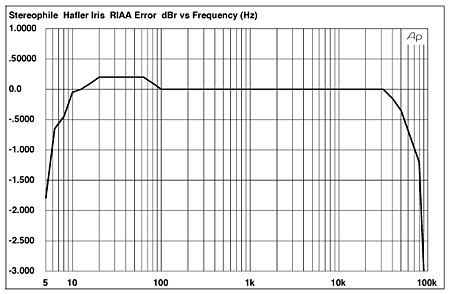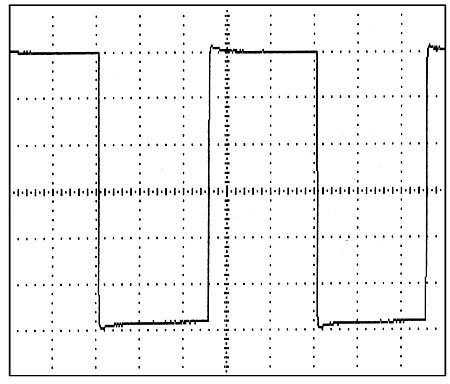| Columns Retired Columns & Blogs |
Hafler Iris preamplifier Measurements
Sidebar 2: Measurements
I regard the fundamental measurement for a phono preamplifier as being the flatness of its RIAA de-emphasis. As can be seen from fig.1, the Hafler Iris is excellent in this respect, being within ±0.05dB across most of the frequency band, though a slight (+0.25dB) lift appears in both the low bass and the top audio octave. The latter probably correlates with the small overshoot apparent on a 5mV 1kHz squarewave fed into the phono input via an inverse-RIAA network (fig.2), though it is hard to explain why the sound should be more HF-lifted—ie, "dry" or "whispy"—than these steady-state measurements would suggest.

Fig.1 Hafler Iris, RIAA error (0.5dB/vertical div.)

Fig.2 Hafler Iris, phono stage, 1kHz squarewave.
Almost as fundamental to good phono sound from a preamplifier is the overload margin. At 1kHz with the input set to MM, this was to spec at 67.5mV, increasing to 765mV at 20kHz. At 20Hz, however, it was somewhat on the low side at approximately 6mV. (Remember, however, that the RIAA pre-emphasis reduces the level cut on disc at 20Hz by almost 20dB compared with 1kHz.) Channel separation with the phono input set to MM was good, at 71dB, 62dB, and 43dB at 20Hz, 1kHz, and 20kHz respectively. The phono input was also quiet, the unweighted noise lying at –61dB with respect to a 500mV output level for the MM setting. Set to MC, the unweighted noise level rose by approximately 12dB. The measured phono-stage gain was slightly higher than spec at 41.3dB, 5mV input giving an output from the tape-out sockets of 580mV. The MC setting gave approximately another 20dB.
The line stage is non-inverting; ie, it's absolute-phase correct, and featured a gain of exactly 23dB, 35mV input at 1kHz giving an output of 500mV with the volume control full up. I measured the maximum output to be 9.2V RMS, given by a line-level input of 660mV; backing off the volume control will increase the effective overload margin on the line inputs until the voltage-swing limit of the input CMOS switching IC is reached, which will be around 5.6V RMS.
The Iris's measured output impedance was higher than specified at 539 ohms, but the preamp should still have no problems in driving reasonably long cables. Measured input impedance for the five line-level inputs was 22k ohms, while the two tape inputs measured 28k ohms, as specified. This is a little low, and might result in premature bass roll-off with, say, a tubed CD player possessing a high output impedance. In general, however, there should be no problems.
Finally, as the "Cyber-Optic" volume control is said to offer superior tracking when compared with a comparable mechanical potentiometer, I checked it out. From full up to the 8 o'clock position, when it was attenuating the output by some 50dB, the channels tracked to within 0.25dB, and as that consistently favored the left channel, was probably due to the balance control being not quite centered. Below that setting, it worsened to a 2dB difference when set to almost full attenuation, but that, frankly, is academic. This is superb volume-control tracking for what is basically an inexpensive preamplifier.—John Atkinson
- Log in or register to post comments




































